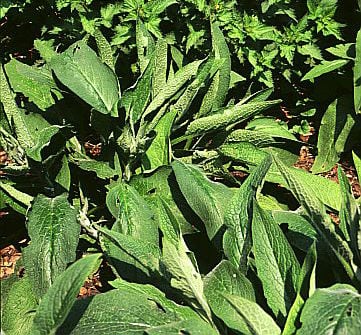Symphytum officinale
common comfrey
Vigorous perennial about 1.5m tall, forming a clump of erect stems bearing coarse, hairy dark green leaves to 25cm in length, with winged stalks, and clusters of tubular, purple, pink or creamy-yellow flowers 2cm in length in late spring and summer
Other common names
alumbackwort
see moreblack root
blackwort
Bohemian comfrey
bone-set
comfrey consound
gum plant
knit-back
bruisewort
healing herb
Size
Ultimate height
1–1.5 metresTime to ultimate height
2–5 yearsUltimate spread
1–1.5 metresGrowing conditions
Moisture
Moist but well–drained, Poorly–drainedpH
Acid, Alkaline, NeutralColour & scent
| Stem | Flower | Foliage | Fruit | |
| Spring | Cream Yellow Pink Purple | Green | ||
|---|---|---|---|---|
| Summer | Cream Yellow Pink Purple | Green | ||
| Autumn | Green | |||
| Winter |
Position
- Full sun
- Partial shade
Aspect
South–facing or North–facing or West–facing or East–facing
Exposure
Exposed or Sheltered Hardiness
H7Botanical details
- Family
- Boraginaceae
- Native to GB / Ireland
- Yes
- Foliage
- Deciduous
- Habit
- Clump forming
- Potentially harmful
- Harmful if eaten repeatedly. Wear gloves and other protective equipment when handling Pets (rabbits, rodents): Harmful if eaten repeatedly - for further information and contact numbers regarding pets, see the HTA guide to potentially harmful plants
- Genus
Symphytum are rhizomatous herbaceous perennials, sometimes invasive, with large leaves and nodding clusters of tubular flowers
- Name status
Correct
- Plant range
- Europe & temperate Asia
How to grow
Cultivation
Grow in moderately fertile, moist soil in sun or partial shade. Be aware the plant growth can be vigorous once established and has the potential to become a nuisance, so may require appropriate management. Can be grown for use as a plant fertiliser
Propagation
Propagate by division of fleshy roots in spring. Propagate by root cuttings in early winter. Propagate by seed sown in pots in a cold frame in autumn or spring
Suggested planting locations and garden types
- Wildlife gardens
- Wildflower meadow
- Cottage and informal garden
Pruning
Can be cut back after flowering to encourage neat, young foliage
Pests
Generally pest-free
Diseases
Generally disease-free
Get involved
The Royal Horticultural Society is the UK’s leading gardening charity. We aim to enrich everyone’s life through plants, and make the UK a greener and more beautiful place.
